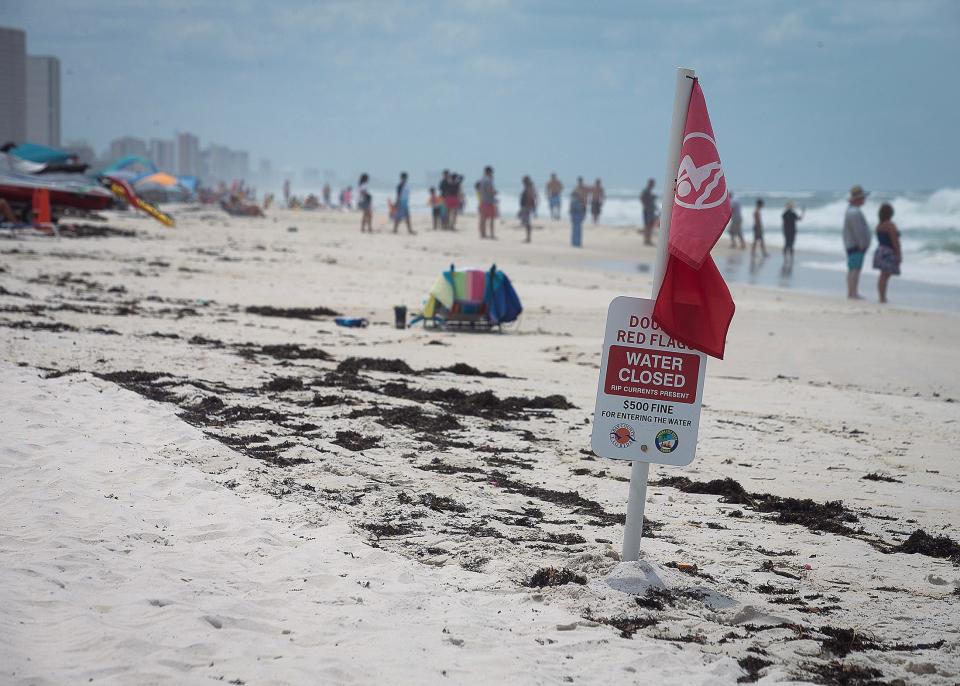PANAMA CITY BEACH ― It’s not wave heights that poses the gravest threat to local beachgoers, but rip currents that lurk beneath the water’s surface.
Because of this, seemingly calm conditions can still kill.
“Along the Emerald Coast, rip currents pose a significant risk to beach patrons, and that’s because they can form anywhere at anytime,” Daryl Paul, beach safety director for Panama City Beach Fire Rescue, said. “It’s primarily because how our sand is in the area. It’s very loose and fine. It moves around very easily with just a little bit of current.”
What are rip currents?
Rip currents are fast-moving currents created by channels in surrounding sandbars. These channels often run perpendicular to the shoreline and cause water to funnel faster out into deeper waters of the Gulf.
Rips can vary in strength, depending on how developed the channels are, and they can sometimes be identified from shore where there is a gap in the wave break ― areas where the white caps of the breaks are less noticeable.
Understanding the beach flag system
In Bay County and Panama City Beach, the strength of rip currents are what determine the color of beach safety flags, not wave heights.

Along the Gulf Coast rip currents, not wave height, post the gravest threat to beachgoers.
“Even though it might look like a calm, very inviting day, that doesn’t mean that you should let your guard down,” Paul said. “You should be looking at the beach warning flags. That is the lifeguard’s first line of communication.”
Common colors used in beach flag warning systems include a green flag for low hazard conditions, a yellow flag for medium hazard conditions, one red flag for high hazard conditions and two red flags for very dangerous conditions.
Bay County and Panama City Beach, however, never fly green flags. Local officials say beachgoers should be cautious anytime they enter the Gulf. It also is illegal year round in Bay and PCB to enter the Gulf under double-red-flag conditions. Violators can be ticketed up to $500.
What to do if you’re caught in a rip current
According to beach safety officials, the best thing a swimmer can do if caught in a rip current is swim parallel to shore, meaning toward the left or right of where they are in distress. If they do this, they can break free from the current, even sometimes landing on a sandbar where they can stand. If they still cannot stand, they will at least be in calmer water where it will be easier to make it back to shore.
“A rip current is just a deep spot in a sandbar,” Paul said. “When you go to the beach and you see waves breaking onto a shallow sandbar … that means in that area, generally speaking, you should be pretty good.
“If you follow that wave when it crashes and it disappears, that means that section in the water right there is deeper.”
How many people have rip currents killed this year in Bay County?
So far this year, two beachgoers have drowned while swimming in the Gulf of America off the coast of Bay County. The first drowning was on was on May 17 near Beach Access 72. The victim was a male in his mid-60s. The second drowning was on June 17. The victim was a 10-year-old boy.
Second PCB drowning of 2025: Alabama boy, 10, drowns while swimming off the coast of Panama City Beach
Past reports note seven people drowned in 2024 while swimming off Bay’s coast. All were tourists who got caught in rip currents. Three of the 2024 drownings happened within the city limits of PCB. They were on March 27, June 20, and June 24. The four other drownings in 2024 happened off unincorporated county beaches. Three were on June 21, and one was on June 23.
“When you go to the beach, first things first, swim near a lifeguard,” Paul said. “There’s lifeguards at the Russell-Fields Pier. Please swim near a lifeguard. If you’re unsure of how to spot a rip current, the lifeguard is there to help.”
Those interested in staying up to date on beach flags can sign up for daily text alerts by texting “PCBFLAGS” to 888777.
This article originally appeared on The News Herald: Here’s what you need to know about rip currents in Panama City Beach
